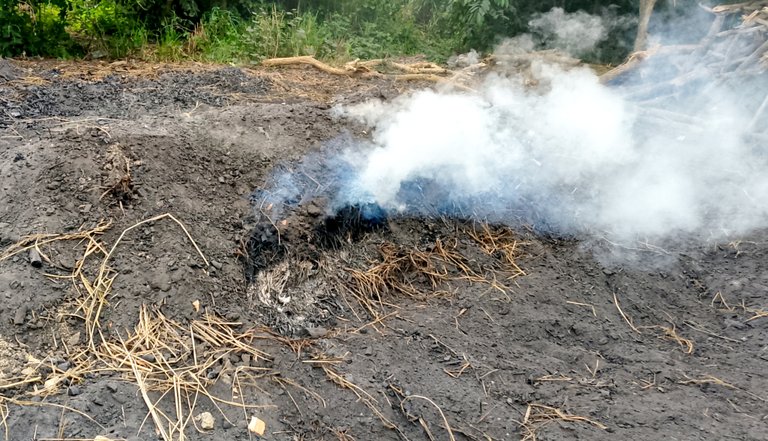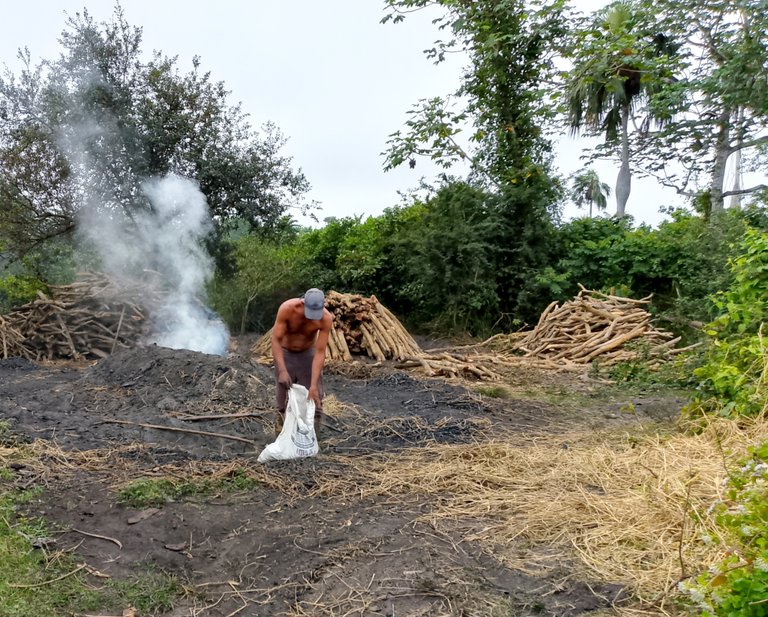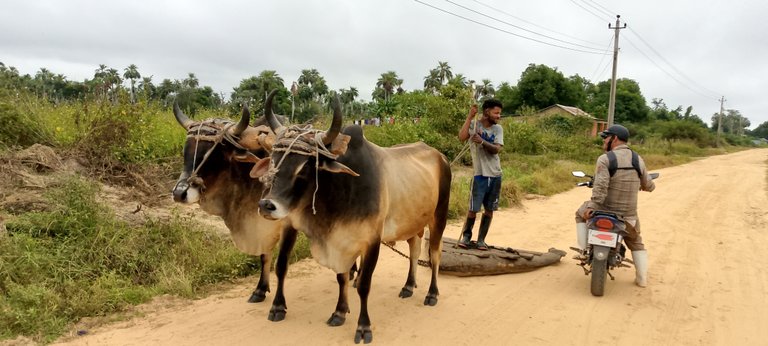
ENGLISH VERSION.
Cuba is a country rich in rural traditions.
Some of them have already been lost in time or have been overshadowed or displaced by technological development or by the same process of social development.
Among these traditions are some that have to do with jobs and trades. .

Today I have been in Buena Vista, one of the oldest and most renowned rural neighborhoods in the municipality of San Luis, and I had the opportunity to witness part of the process of one of these traditions that is purely rural.

In this case I am referring to the trade of "charcoal burner", a tradition that has been maintained, regardless of development.
Since I was a child I have seen very closely this way of creating vegetable fuel, which at the time was of first order for rural households and for many consumers in the capitals.

On my way to the place where I was going to have an art discussion I stopped to take pictures of the construction process of a "kiln" which is the source of the charcoal. Vegetable.
First I was attracted by the fact that from the clearing of a small aromatic grove, at the edge of the royal road, there was a "guajiro" standing on a "rastra" pulled by oxen and who had just finished unloading a load of wood. It had just been felled.

Then, noticing the thick white smoke that a charcoal oven gives off when "it is burning well", I went to the place. There I found, in a single plane, almost the entire process of elaboration of a charcoal oven.
In the "Plan" (circular area where the oven is assembled) I found a charcoal burner collecting the ciscos or remnants of the previous burning.

The ovens can have different shapes.
Some are circular at the base and conical in shape, like birthday hats. Others are made lying down and rectangular in shape, and the least, underground and rectangular, like the typical ones for piglets.

The process of building these tiny domestic volcanoes is quite simple. The magic is to add wood from a center to obtain the desired height, cover it with dry grasses and then seal it with earth on the slope so that the internal combustion can take place. Where the wood burns leaving the vegetable now converted into charcoal ready to be.

By tradition these ovens are built in the mountains where the wood is extracted as its main raw material.
Also in the Plan one could see an oven of the type ''acostado""_ in the process of being raised and more firewood to build the next mini volcano

Since the oven maker takes machete and axe and decides to make an oven, until he packs it in sacks, there is a long way of efforts, and vicissitudes. For it is really a very difficult task, in constant contact with the wounds, the fatigue. The serene, the rain. The night, the cold, etc.

Then come long nights of watching and waiting for the health of the oven, because at the
slightest carelessness can fly, and lose the effort and work of months.
In a future writing I will tell you more about this noble craft,
thanks for the pleasant company!
Text translated with Deellp translator.
Photos taken with my Tecno spark.
VERSION EN ESPAÑOL
Cuba es un país rico en tradiciones campestres.
Algunas ya se han perdido en el tiempo o han sido opacadas o desplazadas por el desarrollo tecnológico o por el mismo proceso del desarrollo social.
Entre esas tradiciones se encuentran algunas que tienen ver con los trabajos y los oficios. .
Hoy he estado en Buena vista, uno de los barrios rurales más antiguos y renombrados del municipio San Luis, y tuve la posibilidad de presenciar parte del proceso de una de esas tradiciones netamente del campo.
En este caso me refiero al oficio de", carbonero", tradición que se ha mantenido, al margen del desarrollo.
Desde niño he visto muy de cerca este modo de crear combustible vegetal, que en su momento fue de primer orden para los hogares rurales y de muchos consumidores en las capitales.
En camino hacia el lugar al que me dirigía a realizar un conversatorio de arte me detuve a tomar imágenes del proceso de construcción de un "Horno" que es la fuente para obtener el carbón. Vegetal.
Primero me atrajo que desde el claro de un pequeño bosquecillo de aroma, a la orilla del camino real, salía un" guajiro" Parado sobre una "rastra" tirada por bueyes y que había terminado de descargar un cargamento de madera. Recién talada.
Entonces, al notar el espeso humo blanco que desprende un horno de carbón cuando" está quemando bien" me dirigí al lugar, Allí encontré, de un solo plano, casi todo el proceso de elaboración de un horno de Carbón vegetal.
En el "Plan" (área circular dónde se ensambla el horno) encontré a un carbonero recogiendo los ciscos o remanentes de la quema anterior.
Los hornos pueden tener formas diferentes.
Unos son circulares en la base y de forma cónica, como los gorritos de cumpleaños. Otros se hacen acostados y de forma rectangular, y los menos, bajo tierra y rectangulares, como los típicos de azar lechones.
El proceso de armar estos pequeñísimos volcanes domésticos.es bastante sencillo. Pues la magia está en adicionar madera desde un centro hasta obtener la altura deseada; revestirlo con hierbas secas y después sellarlo con tierra por la ladera para que se pueda producir la combustión interna. Donde la madera se quema va dejando el vegetal ahora convertido en carbón listo para ser.
Por tradición estos hornos se construyen en los montes de donde se extrae la maderas que su principal materia prima.
También en el Plan se podía ver un horno del tipo ''acostado""_ en vías ser levantado y más leña para construir el próximo mini volcán
Desde que el hornero coge machete y hacha y se decide a hacer un horno, hasta que lo envase a en sacos, hay un largo camino de esfuerzos, y vicisitudes. Pues realmente es tarea muy difícil, en constante contacto con las heridas, el cansancio. El sereno, la lluvia. La noche, el frío, etc.
Después vienen largas noches de vigía y espera al tanto de la salud del Horno, pues al
menor descuido se puede volar, y perderse el esfuerzo y trabajo de meses.
En un próximo escrito les cuento más sobre este noble oficio.
¡Gracias por la agradable compañía!
/DQme8bsE4vv32Xi92wY1NY42LPbvLp2YN4ZqWCZG71LRW2f/1734237067898.jpg)
Texto traducido con Deellp traductor.
Fotos tomadas con mi Tecno spark.

You can check out this post and your own profile on the map. Be part of the Worldmappin Community and join our Discord Channel to get in touch with other travelers, ask questions or just be updated on our latest features.
Sending Love and Ecency Curation Vote!
 Follow Eceny's curation trail to earn better APR on your own HP. : )
Follow Eceny's curation trail to earn better APR on your own HP. : )
Muchas gracias por la visita y el apoyo
Que interesante ver esta publicación de primera mano acerca de este oficio. Muchos utilizamos el carbon pero ni nos preocupamos de su proceso, asi que me alegra que lo mostraras.
Mis respetos a los que realizan esva labor.
Gracias por la visita, que ademas es siempre esperada, y por tu oportuno comentario que tambien aprecio!